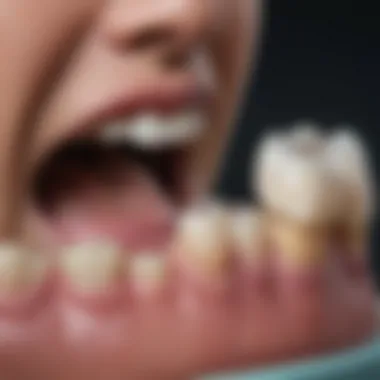Resin Infiltration in Dentistry: A Comprehensive Overview


Intro
Resin infiltration is a technique gaining traction in modern dentistry as a means of dealing with incipient caries. This approach stands out for its minimally invasive nature, which offers a worthy alternative to traditional restorative methods. It assists in the early management of caries and provides an enhancement in the aesthetic appearance of teeth, making it appealing to both practitioners and patients alike.
This article delves into the various dimensions of resin infiltration, from its methodology and clinical applications to the advantages and limitations it presents. By examining different resin materials and their interactions with tooth structures, this comprehensive overview aims to enrich the ongoing dialogue about innovation in preventive and cosmetic dentistry.
Understanding resin infiltration's role is crucial not only for practitioners but also for researchers and educators in the field. The implications of this technique resonate within the scientific community as new findings and methodologies continue to emerge.
Key Findings
Resin infiltration is effective in halting the progression of early carious lesions. The technique utilizes a low-viscosity resin that penetrates lesions, solidifying and reinforcing the tooth structure. This method preserves a significant amount of natural tooth, thus maintaining its integrity.
Summary of the Main Results
- Efficiency: Studies indicate that resin infiltration can effectively arrest lesions that are classified as incipient, particularly in smooth surface areas.
- Aesthetic Benefits: One of the notable findings is the ability of resin infiltration to blend with natural tooth color, enhancing aesthetic outcomes for patients.
Significance of Findings within the Scientific Community
These findings highlight the potential of resin infiltration as a key player in preventive dentistry. The implications stretch beyond individual practice as they challenge existing paradigms surrounding caries management and restorative dentistry.
Implications of the Research
The implications drawn from the research on resin infiltration extend into various domains of dentistry. As techniques like this evolve, they advocate for a shift in how dental practitioners approach caries management.
Applications of Findings in Real-World Scenarios
- Preventive Care: Dental professionals can integrate resin infiltration into routine examinations. For patients with early carious lesions, this method can be employed to avoid more invasive procedures down the line.
- Cosmetic Dentistry: This technique can also be harnessed in cosmetic treatments, allowing for improved aesthetics while maintaining dental function.
Potential Impact on Future Research Directions
As more studies arise surrounding the efficacy and application of resin infiltration, it is poised to pave the roadway for further innovations in dental materials. Research might also investigate long-term outcomes of the technique, further solidifying its place in preventive dentistry.
Resin infiltration constitutes an important advancement within modern practices, warranting attention from dental professionals looking to enhance patient care. This article aims to provide a foundation for understanding this technique's relevance and potential.
Prolusion to Resin Infiltration
Resin infiltration has emerged as a significant advancement in the field of dentistry, particularly in the management of early carious lesions and enhancement of tooth aesthetics. This technique offers a minimally invasive approach, allowing dental professionals to address issues without resorting to more extensive surgical interventions. The essence of resin infiltration lies in its capacity to penetrate and stabilize incipient caries, therefore preventing further progression of the disease.
One of the primary benefits of resin infiltration is its ability to conserve healthy tooth structure. As patients increasingly prioritize preserving their natural dentition, the demand for techniques that embody this principle rises. Understanding resin infiltration not only highlights its practical applications but reinforces the significance of early intervention in dental care. Dental professionals must stay adept in this domain as the popularity of non-invasive procedures continue to grow.
Furthermore, this section serves to introduce a broader discussion surrounding the chemistry and application methods of resin materials, underscoring their pivotal role in contemporary dentistry. By delving into the mechanics and clinical applications of resin infiltration, practitioners can better appreciate how this technique contributes to patient comfort, treatment longevity, and aesthetic outcomes.
The importance of resin infiltration expands beyond mitigating carious lesions; it represents a shift in how dental care is approached and delivered in modern practice.
Understanding Resin Infiltration
Resin infiltration is a process designed to infiltrate the porous structure of early carious lesions, particularly in enamel. Carious lesions that have not yet progressed to cavitation can benefit from this method. The materials used in resin infiltration usually involve light-cured resins that penetrate and bond to the tooth structure, effectively sealing the lesion. This process not only halts the progress of caries but also reduces the appearance of white spot lesions, a common aesthetic concern among patients.
The procedure typically involves steps such as tooth surface preparation, resin application, and curing, each of which requires precision and understanding of the materials involved. Successful resin infiltration relies heavily on the chemical composition of the resin, its viscosity, and its adhesive properties, influencing how deeply it can penetrate into the tooth structure.
Historical Context
Resin infiltration has its roots in the 1980s, emerging substantially with the introduction of adhesive materials and dental composites. The initial intent was to improve bonding techniques, and over the decades, research led to the refinement of materials and methods that specifically tackle incipient caries. Studies have demonstrated that traditional restorative approaches often lead to the unnecessary removal of healthy tooth structure. In contrast, resin infiltration presents a breakthrough by allowing the preservation of tooth integrity while addressing early decay effectively.


The progression of this technique is tied closely to advancements in material science, with newer resin formulations providing enhanced properties such as lower viscosity and greater penetration capability. As the scientific community continues to explore resin infiltration, it becomes evident that ongoing innovation in materials and techniques will play a crucial role in shaping the future of preventive and restorative dentistry.
Mechanics of Resin Infiltration
The mechanics of resin infiltration play a crucial role in understanding how this approach is applied in clinical dentistry. This process is not merely an operational technique; it encompasses the chemical and physical interactions between resin materials and tooth structure, focusing on the benefits derived from their use.
Chemical Composition of Resin Materials
Resin materials used in infiltration are often composed of a combination of methacrylate monomers, such as bisphenol A-glycidyl methacrylate (Bis-GMA) and triethylene glycol dimethacrylate (TEGDMA). These compounds are known for their adhesive properties and ability to penetrate demineralized enamel and dentin. The composition is vital because it determines the viscosity and flow properties of the resin, which ultimately influence its ability to fill microscopic defects in early carious lesions.
The choice of resin material can significantly affect the efficiency of the infiltration process, with variations leading to different adhesive strengths and curing characteristics. Dental professionals must consider these factors to optimize outcomes and ensure longevity of the restoration.
Application Technique
Preparation of the Tooth Surface
The preparation of the tooth surface is essential in the resin infiltration technique. It involves the removal of surface debris and the conditioning of the tooth structure to enhance adhesion. Usually, this is achieved using an acid etch, which demineralizes the surface of the enamel. This process is a beneficial aspect of the technique as it creates a roughened surface that allows the resin to penetrate effectively.
The unique feature here is the improvement in bond strength that results from a clean and well-prepared tooth surface. However, practitioners must be cautious, as excessive etching may inadvertently remove more enamel than desired, affecting the tooth’s aesthetics and health.
Resin Application Process
The resin application process requires precision and care. The resin is applied directly to the prepared surface using a micro brush or a similar tool. The ability of the resin to infiltrate the enamel structure is its primary advantage in this application technique. This characteristic ensures that the resin reaches the depths of the lesion, which is important for effective treatment.
Moreover, the ease of application makes it a popular choice for managing incipient caries. Nonetheless, factors such as ambient light conditions must be monitored, as they can influence the polymerization of the resin.
Curing Process
The curing process is the final step in resin infiltration, essential for achieving a durable outcome. This step typically involves the use of a light-curing device that activates the resin's photo-initiators, resulting in polymerization. A key characteristic of this process is the speed of curing, which minimizes the time the patient must spend in the dental chair.
One unique feature of the curing process is the potential for dual curing technology, allowing for both light and chemical activation. This flexibility ensures thorough hardening of the resin in difficult-to-reach areas. However, improper curing can lead to incomplete polymerization, resulting in compromised integrity and longevity of the restoration.
"The success of resin infiltration relies heavily on a precise technique and thorough understanding of material properties."
In summary, the mechanics of resin infiltration encompass essential elements that impact the overall efficacy of the treatment. Careful attention to the chemical composition of resin materials, along with meticulous application techniques ensures that dental professionals can harness the full potential of this method.
Clinical Applications
Resin infiltration in dentistry finds broad relevance in multiple clinical contexts. Its application extends beyond mere cosmetic benefits, delving deeply into effective management of incipient dental caries. This section explores two primary clinical facets: caries management and aesthetic enhancement.
Caries Management
The cornerstone of resin infiltration lies in its approach to caries management. Traditional interventions, such as fillings, often entail invasive procedures that may compromise additional tooth structure. In contrast, resin infiltration strives for a minimally invasive route. This method targets early-stage carious lesions that are not yet cavitated. By employing resin infiltration, dental professionals can arrest the progression of caries effectively.
The procedure involves the application of a low-viscosity resin that penetrates the porous structure of affected enamel. This leads to the mechanical occlusion of carious pathways, thus preventing further degradation. The advantages are multifactorial:
- Preservation of enamel - Unlike conventional methods, this approach minimizes the loss of healthy tooth structure.
- Enhanced remineralization - By sealing micro-cavities, the technique allows for natural remineralization processes to occur more efficiently.
- Reduced discomfort - The procedure typically requires less anesthesia than more invasive treatments, leading to greater patient comfort.
Aesthetic Enhancement
Aesthetic enhancement is another critical application of resin infiltration. In a dental practice, the demand for visually appealing results is paramount, especially in procedures involving anterior teeth. The resin materials utilized in infiltration are selected for their optical properties, thus allowing them to blend harmoniously with natural enamel.
This technique provides:
- Improved coloration - Resin infiltration can address issues of intrinsic staining, allowing for a more uniform color across the affected tooth surface.
- Surface smoothness - The infiltration process restores the smooth texture of enamel, significantly enhancing the aesthetic appearance.
- Light transparency - Modern resins are designed to mimic the translucency of natural enamel, contributing to a more natural look.


Resin infiltration is essential not only for managing caries but also for enhancing patient comfort and aesthetic outcomes.
Advantages of Resin Infiltration
The advantages of resin infiltration in dentistry encompass several aspects that reflect its significance in modern dental practice. These advantages are crucial when considering treatment options for patients with incipient caries or aesthetic concerns. Understanding these benefits can help clinicians make informed decisions about the best course of action in managing dental issues.
Minimally Invasive Nature
One of the foremost advantages of resin infiltration is its minimally invasive nature. Unlike traditional restorative procedures that may require extensive tooth structure removal, resin infiltration aims to preserve as much of the natural tooth as possible. With this technique, only a small amount of enamel is removed to allow for resin penetration. This approach reduces the need for crowns or fillings in early caries cases, thus minimizing damage to healthy tooth structures.
In terms of patient comfort, this method results in less sensitivity post-treatment. Furthermore, because the procedure is less invasive, it can be particularly appealing to patients who are anxious about dental work. By using resin infiltration, dental practitioners can apply a conservative treatment strategy that not only respects the integrity of healthy enamel but also supports the long-term health of the tooth.
Preservation of Tooth Structure
Another significant advantage is the preservation of tooth structure. By using resin infiltration, dentists can seal and stabilize early carious lesions without resorting to more aggressive restoration techniques. Studies have shown that when resin is properly infiltrated into porous lesions, it not only halts the progression of caries but also strengthens the remaining tooth structure.
Maintaining the natural architecture of the teeth allows for better long-term outcomes. This preservation minimizes the risk of further decay and other complications associated with more traditional interventions. Patients appreciate the ability to retain their natural teeth, which can lead to higher satisfaction levels and better health outcomes in the long run.
Improved Aesthetics
The aesthetic outcomes of resin infiltration are particularly noteworthy. The use of clear or tooth-colored resins enables effective camouflage of discolored or aesthetically displeasing areas in the teeth. This is especially relevant for individuals looking for options that improve their smile without undergoing significant restoration work.
Resin infiltration can restore the natural appearance of teeth affected by incipient caries, enhancing the visual appeal without making them look artificially altered. In this regard, resin infiltration fills a gap between simple cosmetic enhancements and more invasive dental procedures. Clinicians can provide their patients with solutions that not only improve their dental health but also address their aesthetic concerns.
The success of resin infiltration lies in its ability to combine preventive dental care with aesthetic considerations.
Overall, the advantages of resin infiltration—minimally invasive nature, preservation of tooth structure, and improved aesthetics—paint a compelling picture for practitioners contemplating this method in their practice.
Limitations and Considerations
Understanding the limitations and considerations associated with resin infiltration is crucial for dental professionals. While this technique offers many benefits, such as a minimally invasive approach and aesthetic improvement, it is also important to acknowledge the potential drawbacks. This section will delve into specific elements related to risks, management in severe cases, and strategies to address these issues.
Potential Risks and Complications
Resin infiltration, while beneficial, is not free of potential risks and complications. One significant concern is the possibility of an inadequate seal between the resin material and the tooth structure. This could result in moisture infiltration underneath the resin, leading to secondary caries or microleakage over time. Additionally, allergic reactions to the resin components, though rare, can occur in some individuals.
Another risk pertains to improper application, which may result in an uneven surface texture or discoloration once the resin is cured. Dentists must ensure stringent adherence to established protocols to mitigate these complications.
Limitations in Severe Caries Cases
Resin infiltration is not suitable for all cases, particularly those involving extensive or deep carious lesions. In severe caries cases, where significant tooth structure is compromised, resin infiltration may not provide adequate retention or protection. The technique is designed for early-stage caries, specifically in lesions that are non-cavitated.
When dealing with advanced decay, traditional restorative methods, such as crowns or fillings, are often necessary to address the underlying structural integrity of the tooth. This can limit the application of resin infiltration in patients with significant dental decay, making it essential for practitioners to evaluate the extent of caries before opting for this approach.
Measures to Mitigate Risks
To effectively manage risks and maximize the benefits of resin infiltration, several measures should be considered. First, proper training and education of dental professionals are essential. Understanding the nuances of resin materials, as well as mastering the application technique, will help reduce the likelihood of complications.
Implementing a thorough pre-treatment assessment is also critical. This includes evaluating the patient’s caries progression, overall oral hygiene, and any existing restorations. If necessary, dentists should consider adjunctive treatments, such as fluoride application, to help remineralize incipient caries before resin infiltration.
Finally, consistent follow-up appointments should be scheduled. These allow for monitoring of the treated areas, ensuring that any issues are detected and addressed promptly.
Adopting preventive measures can lead to better outcomes and increased patient satisfaction in the long run.
In summary, acknowledging the limitations and considerations of resin infiltration is essential for optimal patient care. By understanding the potential risks, recognizing limitations in severe cases, and implementing robust mitigation strategies, dental professionals can harness the advantages of this technique while minimizing disadvantages.


Comparative Analysis with Traditional Treatments
The comparison of resin infiltration to conventional restorative treatments is essential to understand its unique position within the field of dentistry. As the dental landscape evolves, practitioners must select the best strategies that address patient needs effectively while minimizing invasiveness. This section provides an in-depth look at resin infiltration and how it stands up against traditional methods.
Resin Infiltration vs. Conventional Restorations
Resin infiltration offers a different approach compared to traditional restorations such as fillings, crowns, or other more invasive treatments. Here are key points of comparison:
- Invasiveness: Resin infiltration is significantly less invasive than drilling and placing traditional restorations. This technique preserves more of the healthy tooth structure, making it an appealing option for patients who wish to avoid extensive procedures.
- Material Application: Unlike conventional materials that are used to fill cavities, resin infiltration works primarily on early carious lesions by penetrating and stabilizing the enamel without removing affected tissue. This can be crucial for retaining the structural integrity of the tooth.
- Durability: Traditional restorations, like amalgam or composite resin fillings, may tend to wear down over time and require replacements. Resin infiltration, on the other hand, aims to halt the progression of caries and enhance the appearance without creating additional compromise on the tooth.
- Restoration Appearance: The aesthetic outcomes from resin infiltration are often superior, as the resin is designed to blend well with the natural tooth structure. Conventional restorations might not always match the aesthetics of the surrounding teeth, and adjustments may be needed.
"The choice between resin infiltration and traditional restorations hinges on the condition of the tooth, patient preferences, and the dental professional’s assessment of each case."
Cost-Effectiveness
When analyzing the cost-effectiveness of resin infiltration compared to traditional treatments, there are several factors to consider:
- Initial Costs: While resin infiltration materials may have a higher upfront cost than traditional materials, the long-term costs associated with maintenance and replacement of conventional restorations can be significant. Fewer visits to the dentist for replacements or adjustments can save patients both time and money in the long run.
- Treatment Longevity: The longevity of a non-invasive procedure like resin infiltration can also be economically advantageous. By potentially preserving tooth structure and delaying the need for more complex restorations, the overall treatment costs may decrease over time.
- Patient Satisfaction: Higher patient satisfaction with minimally invasive procedures often translates to positive word of mouth and a loyal patient base. This indirect impact on practice revenue can enhance the economic feasibility of adopting newer techniques.
In summation, while both resin infiltration and conventional options have their place in dental practice, the comparative elements of invasiveness, durability, aesthetics, and overall costs should guide practitioners in making informed decisions. With advancements in resin materials and techniques, resin infiltration is carving out an important niche in modern dentistry.
Future Trends in Dental Resin Infiltration
The landscape of dental resin infiltration is undergoing significant changes. Understanding these trends is crucial for professionals aiming to keep pace with innovative techniques in the field. Future trends involve improvements in materials, methodologies, and the digital integration of techniques that promise enhanced efficacy and patient outcomes.
Advancements in Resin Materials
Recent developments in resin materials are noteworthy. Manufacturers are focusing on creating resins that exhibit superior mechanical properties and lower viscosity. These changes allow for better penetration into tooth structures, which is essential for effective infiltration treatment. New composite resins also aim to mimic natural tooth coloration more closely.
- Biocompatibility: New formulations prioritize biocompatibility to minimize adverse reactions in patients.
- Mechanical Strength: Samples tested show increased resistance to wear and fracture.
- Fluorescence: Enhanced fluorescence properties contribute to a more natural appearance under clinical lighting.
These advancements make resin infiltration a more appealing option for both practitioners and patients, leading to effective long-term solutions for dental issues.
Integration with Digital Dentistry
Digital dentistry is reshaping various facets of dental practice, and resin infiltration is no exception. Incorporating digital technologies improves accuracy and efficiency.
- Intraoral Scanners: These devices capture precise data, allowing for customized treatment plans.
- CAD/CAM Technology: Computer-aided design and manufacturing streamline the process of creating custom dental materials, aligning perfectly with the infiltration technique.
- 3D Imaging: It enhances diagnostic capabilities, helping to assess the extent of caries and treatment needs.
The synergy between resin infiltration and digital technologies ultimately leads to improved patient experiences. As clinicians embrace these tools, they achieve more predictable and satisfying outcomes, solidifying the role of resin infiltration in modern dental practices.
"As digital integration progresses, resin infiltration can expect substantial refinement, leading to enhanced clinical results and patient satisfaction."
In summary, the future trends in dental resin infiltration reflect a dynamic shift toward improved materials and advanced technologies. These developments position resin infiltration as a pivotal method in contemporary dentistry.
The End
The understanding of resin infiltration in dentistry is critical in today’s dental practices. The technique offers a minimally invasive method for treating incipient caries. This section distills the findings presented in the article and outlines practical recommendations for practitioners.
Summary of Findings
Resin infiltration has emerged as a valuable tool in caries management and aesthetic enhancement. This technique targets early-stage carious lesions, allowing for a non-invasive approach that preserves tooth structure. The key points from the article include:
- Mechanics of Resin Infiltration: This involves a detailed understanding of the chemical composition of resins and the precise technique for application that ensures effective infiltration and curing.
- Clinical Applications: The approach not only addresses caries but also plays a significant role in improving the cosmetic appearance of teeth, appealing to a wide range of patients.
- Advantages: The procedure has advantages including its minimally invasive nature, which helps to maintain the integrity of surrounding tooth structure, thus leading to better long-term outcomes.
- Limitations: Although effective in many cases, certain limitations exist, particularly in instances of severe caries where alternative treatments may be required.
- Future Trends: Ongoing advancements in materials and integration with digital dentistry signal a promising future for resin infiltration techniques.
Recommendations for Practitioners
For dental practitioners, embracing resin infiltration can enhance treatment offerings significantly. The following recommendations should be considered:
- Training and Education: Dentists should seek out training on the latest techniques in resin infiltration to ensure they are equipped with the necessary skills.
- Patient Assessment: Evaluate patients on a case-by-case basis to determine suitability for resin infiltration, considering both the extent of caries and the patient’s dental health.
- Material Selection: Practitioners should stay informed about advancements in resin materials to choose the most effective options based on their clinical application.
- Patient Communication: Openly discuss treatment options with patients, highlighting the benefits and limitations of resin infiltration to allow informed decision-making.
- Follow-Up Care: Regular follow-ups post-treatment are important to monitor the effectiveness of infiltration and the health of the affected teeth.
Overall, resin infiltration represents a pivotal shift in dental care strategies. Its integration into routine practice can improve patient outcomes and enhance aesthetic results, making it a worthwhile consideration for modern dental practice.







